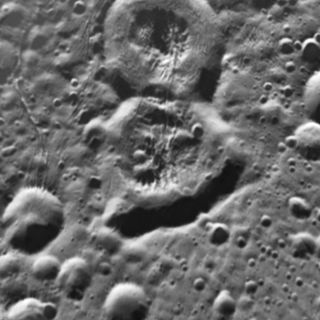
The humerus is a long bone in the arm that runs from the shoulder to the elbow. It connects the scapula and the two bones of the lower arm, the radius and ulna, and consists of three sections. The humeral upper extremity consists of a rounded head, a narrow neck, and two short processes. The body is cylindrical in its upper portion, and more prismatic below. The lower extremity consists of 2 epicondyles, 2 processes, and 3 fossae. As well as its true anatomical neck, the constriction below the greater and lesser tubercles of the humerus is referred to as its surgical neck due to its tendency to fracture, thus often becoming the focus of surgeons.

The posterior cranial fossa is part of the cranial cavity, located between the foramen magnum and tentorium cerebelli. It contains the brainstem and cerebellum.
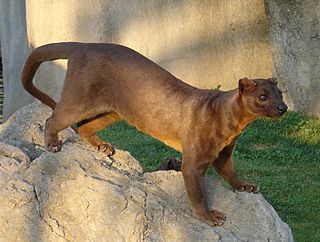
The fossa is a cat-like, carnivorous mammal endemic to Madagascar. It is a member of the Eupleridae, a family of carnivorans closely related to the mongoose family (Herpestidae). Its classification has been controversial because its physical traits resemble those of cats, yet other traits suggest a close relationship with viverrids. Its classification, along with that of the other Malagasy carnivores, influenced hypotheses about how many times mammalian carnivores have colonized Madagascar. With genetic studies demonstrating that the fossa and all other Malagasy carnivores are most closely related to each other, carnivorans are now thought to have colonized the island once, around 18 to 20 million years ago.

The cubital fossa or elbow pit is the triangular area on the anterior view of the elbow of a human or other hominid animal. It lies anteriorly to the elbow when in standard anatomical position.

In human anatomy, the pterygopalatine fossa is a fossa in the skull. A human skull contains two pterygopalatine fossae—one on the left side, and another on the right side. Each fossa is a cone-shaped paired depression deep to the infratemporal fossa and posterior to the maxilla on each side of the skull, located between the pterygoid process and the maxillary tuberosity close to the apex of the orbit. It is the indented area medial to the pterygomaxillary fissure leading into the sphenopalatine foramen. It communicates with the nasal and oral cavities, infratemporal fossa, orbit, pharynx, and middle cranial fossa through eight foramina.

The jugular fossa is a deep depression in the inferior part of the base of the skull. More specifically, it is located in the temporal bone, posterior to the carotid canal and the aquæductus cochleæ. It is of variable depth and size in different skulls; it lodges the bulb of the internal jugular vein.

The pterygoid processes of the sphenoid, one on either side, descend perpendicularly from the regions where the body and the greater wings of the sphenoid bone unite.
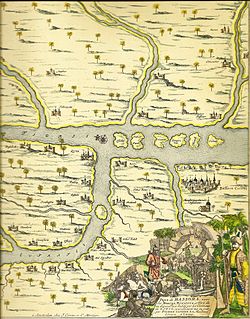
There are over 300,000 Catholics living in Iraq, just 0.95% of the total population. The Catholics of Iraq follow several different rites, but most are members of the Chaldean Catholic Church. There are 17 currently active dioceses and eparchies in Iraq.

The mandibular fossa is the depression in the temporal bone that articulates with the mandible. In the temporal bone, the mandibular fossa is bounded anteriorly by the articular tubercle and posteriorly by the tympanic portion of the temporal bone, which separates it from the external acoustic meatus. The fossa is divided into two parts by a narrow slit, the petrotympanic fissure.
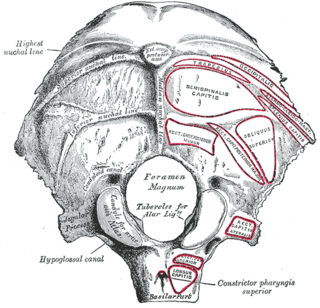
Behind either condyle of the lateral parts of occipital bone is a depression, the condyloid fossa, which receives the posterior margin of the superior facet of the atlas when the head is bent backward; the floor of this fossa is sometimes perforated by the condyloid canal, through which an emissary vein passes from the transverse sinus.
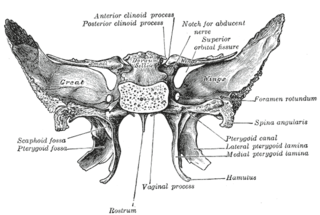
The pterygoid fossa is an anatomical term for the fossa formed by the divergence of the lateral pterygoid plate and the medial pterygoid plate of the sphenoid bone.

The infraspinatous fossa of the scapula is much larger than the supraspinatous fossa; toward its vertebral margin a shallow concavity is seen at its upper part; its center presents a prominent convexity, while near the axillary border is a deep groove which runs from the upper toward the lower part.

The supraspinatous fossa of the posterior aspect of the scapula is smaller than the infraspinatous fossa, concave, smooth, and broader at its vertebral than at its humeral end. Its medial two-thirds give origin to the Supraspinatus.

The iliac fossa is a large, smooth, concave surface on the internal surface of the ileum. The fossa is bounded above by the iliac crest, and below by the arcuate line; in front and behind, by the anterior and posterior borders of the ileum.
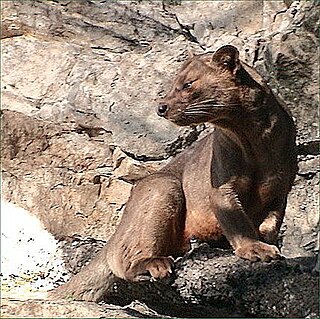
Eupleridae is a family of carnivorans endemic to Madagascar and comprising 10 known living species in seven genera, commonly known as euplerids, or Malagasy mongooses. The best known species is the fossa, in the subfamily Euplerinae. All species of Euplerinae were formerly classified as viverrids, while all species in the subfamily Galidiinae were classified as herpestids.

Euplerinae, more commonly known as malagasy civets, is a subfamily of carnivorans that includes four species restricted to Madagascar. Together with the subfamily Galidiinae, which also only occurs on Madagascar, it forms the family Eupleridae. Members of this subfamily, which include the fossa, falanoucs and Malagasy civet, were placed in families like Felidae and Viverridae before genetic data indicated their consanguinity with other Madagascar carnivorans. Within the subfamily, the falanouc and Malagasy civet are more closely related to each other than to the fossa.
In anatomy, a fossa is a depression or hollow, usually in a bone, such as the hypophyseal fossa. Some examples include:
The Chaldean Catholic Archeparchy of Basra is a non-metropolitan Archeparchy of the Chaldean Catholic Church in southern Irak.
The Chaldean Catholic Eparchy of Beirut is the sole eparchy of the Chaldean Catholic Church for all Lebanon.
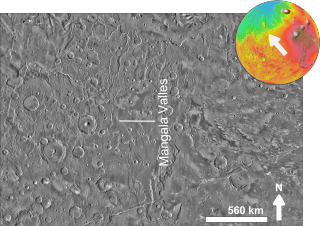
Mangala Fossa is a graben in the Memnonia quadrangle of Mars, located near 11.6°S 151.0°W, which originated in the Hesperian and Amazonian epochs. The graben is located at the head of the outflow channel Mangala Valles, which is thought to have been formed by at least two catastrophic flood events during the same geological period, leading to the release of vast quantities of water from Mangala Fossa onto the Martian surface. The flooding was probably initiated by the emplacement of a dike radiating from the volcano Arsia Mons, resulting in the formation of the graben, Mangala Fossa, at the channels' head. This dike breached a pressurized aquifer trapped beneath a thick "cryosphere" beneath the surface. As the floor of the graben subsided, water found its way up one or both of the faults in the crust that defined the edges of the graben and spilled into the depression, eventually filling it and overflowing at the lowest point on the rim to erode the Mangala Valles channels.

